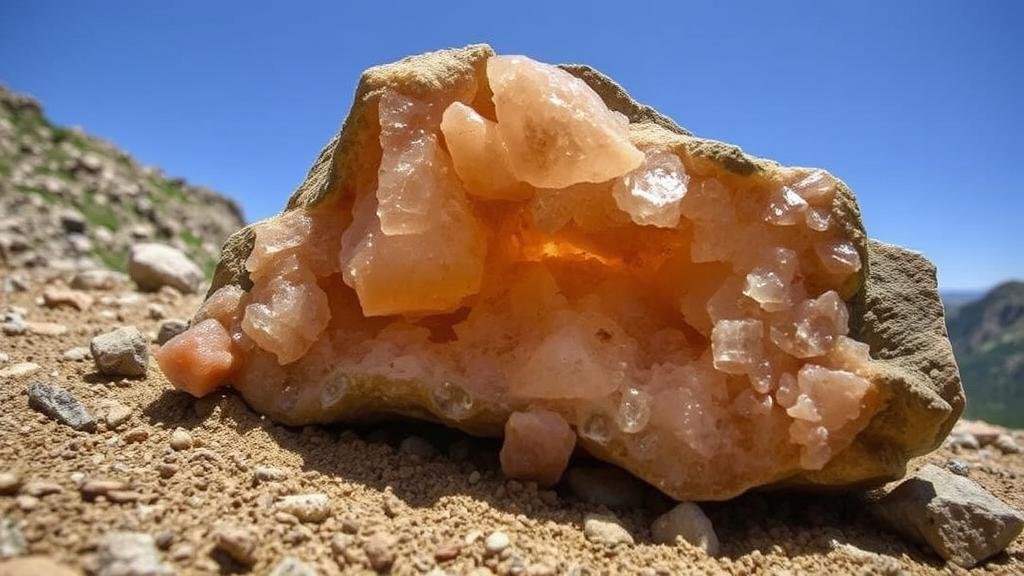Excavating quartz geodes in Spain’s Pyrenees Mountains, revealing crystalline surprises.
Excavating Quartz Geodes in Spain’s Pyrenees Mountains
For rockhounds and mineral collectors, few experiences rival the thrill of discovering quartz geodes. Nestled in the stunning landscape of Spain’s Pyrenees Mountains, these natural wonders present a unique opportunity to unearth crystalline treasures hidden within the earth. This article will delve into the geology of quartz geodes, the specifics of hunting for them in the Pyrenees, and practical advice for enthusiasts eager to embark on this exciting expedition.
The Geology of Quartz Geodes
Quartz geodes are hollow spheres lined with crystalline mineral deposits, primarily made of quartz (SiO2). formation of these geodes begins when volcanic or sedimentary rock expands, creating voids over time. Mineral-rich water seeps into these spaces, depositing silica and other minerals as it evaporates. As this process continues over thousands to millions of years, the impregnation of silica leads to the development of quartz crystals. Some notable features of quartz geodes include:
- Average sizes range from 5 to 30 centimeters in diameter.
- Stalactites and stalagmites can form within larger geodes, creating intricate structures.
- Color variations caused by inclusions such as iron or manganese result in hues ranging from clear to amethyst purple.
The Pyrenees: A Geological Playground
Spain’s Pyrenees Mountains are a hotspot for geological diversity due to their tectonic history. The mountain range showcases limestone, slate, and volcanic rock, providing ideal conditions for quartz geode formation. Notably, the area has produced some of the country’s most beautiful specimens, enriched by its unique climatic morphology. Northern regions, particularly around Aguero and Huesca, are known for yielding quartz geodes that attract both amateur and professional mineral collectors.
Best Practices for Collecting Quartz Geodes
When venturing into the Pyrenees for geode collecting, proper techniques and respect for the environment are critical. Here are essential practices:
- Research Locations: Familiarize yourself with authorized dig sites. Some locations may require permission or have specific regulations.
- Essential Gear: Equip yourself with tools such as a geological hammer, safety goggles, gloves, and sturdy footwear to ensure safety during excavations.
- Seasonal Timing: The best times to explore are during spring and early autumn when the weather is milder and ground conditions are optimal.
- Respect Nature: Practice Leave No Trace principles to preserve the area’s natural beauty and geological integrity.
Real-World Applications and Collectibility
Quartz geodes not only serve an aesthetic purpose but also have practical applications. crystals can enhance the ambiance of living spaces, used in jewelry, and even feature in spiritual practices for their believed healing properties. Plus, quartz is an essential component in various industries, including electronics and glass-making.
Collectors should be mindful that the value of geodes can fluctuate based on size, quality, and rarity. A well-formed geode can fetch prices from $20 to several hundred dollars at mineral shows and online auctions. Also, preserving the geode in its natural state–without cutting or polishing–often retains greater value for collectors.
Actionable Takeaways
Exploring for quartz geodes in Spain’s Pyrenees Mountains can be a rewarding endeavor for rockhounds and mineral collectors. By understanding the geological context, proper collection techniques, and the potential value of your finds, you can enrich your collecting experience. Remember to:
- Conduct thorough research on gathering locations and regulations.
- Prepare with the right tools and gear.
- Foster an appreciation for the geological wonders while ensuring environmental stewardship.
With these guidelines, you are now ready to embark on an unforgettable journey filled with crystalline surprises waiting to be unearthed in the majestic Pyrenees.



